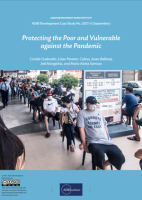
More consumers and businesses have adopted digital payment systems, such as e-wallets, which enable contactless transactions during the pandemic. Photo credit: ADB.
Research by Google, Temasek, and Bain shows the digital economy in Southeast Asia could grow beyond the pandemic to $1 trillion by 2030. The largest economy, Indonesia, could become twice the size of the regional market today.
Research by Google, Temasek, and Bain shows the digital economy in Southeast Asia could grow beyond the pandemic to $1 trillion by 2030. The largest economy, Indonesia, could become twice the size of the regional market today.
“We now forecast that the digital economy will reach $174 billion in gross merchandise value by the end of 2021 and pick up pace to hit $363 billion by 2025, well above last year’s estimate of $300 billion,” wrote Stephanie Davis, Google’s vice-president for Southeast Asia, in a recent blog post. “For the first time, we also make a 2030 forecast—projecting that the digital economy could reach a value of $1 trillion by the end of the decade. Growth on that scale would see Southeast Asia help define the future of technology globally.”
The upbeat forecast for the region bodes well for countries that are gearing up to use digitalization as the linchpin for their economic recovery from the COVID-19 crisis.
The 6th edition of the e-Conomy SEA report was released by the three companies this week. It estimates the size of the digital economy in terms of gross merchandise value (GMV) or the sum of goods sold through customer-to-customer platforms. The report covers Indonesia, Malaysia, Philippines, Singapore, Thailand, and Viet Nam, which together account for roughly 90% of Southeast Asia’s total population. It is based on a survey of 9,402 consumers and 3,036 small businesses that use digital tools, usually in food services and retail. This is the first time digital merchants are profiled in the report.
Double-digit growth is forecast for all six countries this year with the Philippines leading the pack at a compounded annual rate of 93%. A 132% growth in e-commerce is seen to enlarge the country’s 2021 GMV to $17 billion.
Indonesia will have the highest sales in 2021 at $70 billion, or about 40% of the regional GMV, followed by Thailand at $30 million and Malaysia and Viet Nam at $21 million each.
The pandemic factor
“Technology has been critical in helping Southeast Asians get through the COVID-19 pandemic,” Davis said.
On Temasek’s website, Rohit Sipahimalani, its chief investment strategist and head of Southeast Asia, noted that “the pandemic has led to accelerated and enduring digital adoption in Southeast Asia, which has propelled its internet economy to new heights.”
Lockdowns and mobility restrictions drove more people in the region to go online to buy food and other essentials, to pay their bills, to continue their studies or work, and even for entertainment. They include those that used such digital services for the first time.
A way of life
According to the report, there are now 440 million internet users in Southeast Asia, with 40 million new users added every year since 2019. Internet penetration in the region is estimated at 75%. Majority of new users are from non-metropolitan areas. The Philippines and Thailand have the highest proportion of new digital consumers during the pandemic (until the first half of 2021) at 20% and 18%.
Southeast Asians have embraced the digital lifestyle. Eight in 10 internet users in the region have made an online purchase at least once. The report says pre-pandemic users are using up to four more digital services now, while 9 in 10 new digital consumers continue to use the service that they signed up for in 2020.
The surveys show increased use of e-wallets by both consumers and merchants. Malaysia and the Philippines have the biggest increases in e-wallet payments.
“Today, 90% of these merchants accept digital payments, and one in three believe they wouldn’t have survived the pandemic without going online,” said Davis. They will likely stay online even after COVID-19 with 80% of them expecting to make more than half their sales from online sources over the next 5 years.
Digital decade
e-Commerce, food delivery and digital financial services are driving growth in the region toward the trillion-dollar mark. The report expects online shopping to become “the norm for consumers of all ages, in both urban and rural areas” and make up more than two-thirds of the GMV by 2030. Digital adoption was fastest in food delivery during the pandemic, and it is likely to rise further as internet penetration and e-wallet use increase in non-metropolitan areas. Digital lending is also expected to increase because of growing options and demand for consumer and supply chain financing.
The digital economy in Indonesia could grow five times its size today to $330 million by the end of the decade. Viet Nam is forecast to become the second biggest market with its GMV reaching $220 million by 2030, followed by Thailand and the Philippines at $160 million and $150 million.
Investments in the digital economy are at a record high in 2021 with the value of deals in the region at $11.5 billion in the first semester, compared with $11.6 billion in the whole of 2020. There is strong investor appetite for e-commerce (particularly logistics) and digital financial services. Unicorns cornered 49% of investments in 2021. Indonesia surpassed Singapore as the hottest investment destination in the region.
This article was first published by BIMP-EAGA on 12 November 2021.

BIMP-EAGA
The Brunei Darussalam–Indonesia–Malaysia–Philippines East ASEAN Growth Area, or BIMP-EAGA, is a cooperation initiative established in 1994 to spur development in remote and less developed areas in the four participating Southeast Asian countries.


